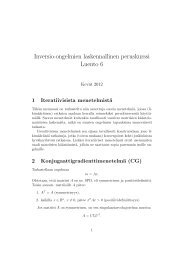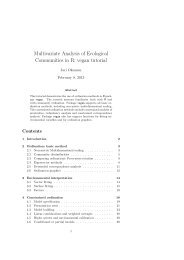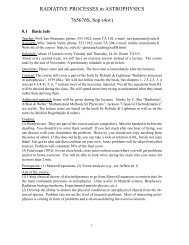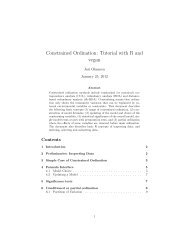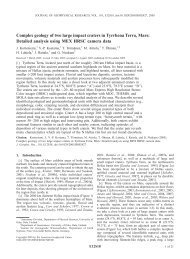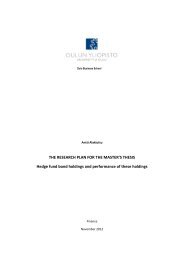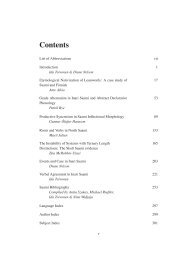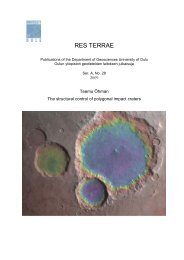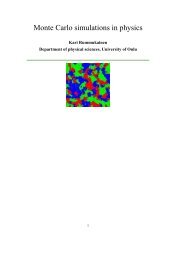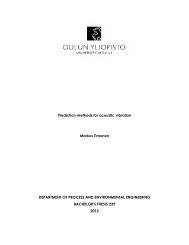Juha Köykkä - Oulu
Juha Köykkä - Oulu
Juha Köykkä - Oulu
- TAGS
- juha
- oulu
- cc.oulu.fi
Create successful ePaper yourself
Turn your PDF publications into a flip-book with our unique Google optimized e-Paper software.
Res Terrae, Ser. A 32, J. <strong>Köykkä</strong>, Sedimentology of the Mesoproterozoic Telemark basin-fills, South Norway: implications for<br />
sedimentation processes, depositional environments and tectonic evolution<br />
3.3.2 Early Sveconorwegian units<br />
The sedimentation of the early Sveconorwegian units is bracketed between ca. 1170<br />
and 1019 Ma (Lamminen et al., 2009b and Fig. 4). These units are more complex due<br />
to deformation and faulting, and the lithostratigraphical correlation of different units is<br />
problematic. The early Sveconorwegian units comprise the Oftefjell, Høydalsmo, Lifjell,<br />
and Heddals Groups; the Brunkeberg and Eidsborg formations; the Transtaulhøgdi supra-<br />
crustals, which are separated by the sub-Lifjell, sub-Røynstaul, and sub-Heddal unconfor-<br />
mities; and a possible sub-Eidsborg unconformity (Figs. 3, 4). The whole succession con-<br />
sists mainly of coarse-grained sedimentary rocks interbedded with bimodal magmatic<br />
rocks. On a regional scale, the formations are laterally restricted and lithologically varia-<br />
ble, and their true thickness is unknown. Although the sedimentary features, depositional<br />
environments, and lateral correlations of the different units are not well known, some of<br />
the general lithostratigraphical features are summarized here.<br />
The sub-Svinsaga angular unconformity is overlain by the ca. 1-km-thick Oftefjell<br />
Group. The Oftefjell Group starts with the ca. 250-m-thick Svinsaga Formation, which<br />
consists of basal sedimentary breccias, conglomerates, sandstones and mudstones de-<br />
posited in the fluvial-lacustrine environment. The sedimentation patterns and paleohy-<br />
drology of the Svinsaga Formation are treated in Paper VI. The Svinsga Formation is<br />
overlain by the felsic porphyres, minor volcanic conglomerates and sandstones inter-<br />
beds of the Robekk and Ljosdalsvatnet Formations. The age determinations from the<br />
Ljodalsvatnet felsic porphyre (ca. 1155 ± 3 Ma) indicate that it can probably be corre-<br />
lated with the Brunkeberg Formation (ca. 1155 ± 2 Ma) in the east (see Laajoki et al.,<br />
2002).<br />
The Oftefjell Group is overlain by the ca. 1-1.5-km thick Høydalsmo Group, sepa-<br />
rated by the sub-Røynstaul unconformity (Fig. 4). The volcanic-sedimentary Høydalsmo<br />
Group starts with the conglomerate-dominated Røynstaul Formation followed by the mafic<br />
lava-dominated Morgedal Formation. The Morgedal Formation is overlain by the porphyre<br />
of the Dalaå Formation (ca. 1150 ± 4 Ma, Laajoki et al., 2002) and, again, the mafic lavas<br />
of the Gjuve Formation with minor sedimentary interbeds (Fig. 4). In the west, the Brun-<br />
keberg Formation is overlain by the Transtaulhøgdi supracrustals and the Lifjell Group,<br />
and the two are separated by the sub-Lifjell unconformity (Fig. 4). The Lifjell Group com-<br />
prises the Heksfjellet conglomerates followed by the sedimentary-dominated Vallar Bru<br />
34



